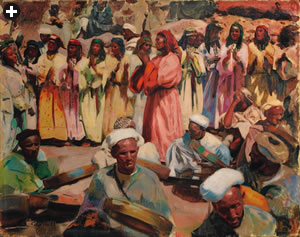 |
| SOTHEBY’S |
| “L’Aouche,” by Jacques Majorelle, one of few Orientalists to move toward abstraction. |
Not far away from Christie’s, the Tate Britain’s major summer exhibition was titled “The Lure of the East: British Orientalist Painting.” And more telling still are the subsequent venues hosting the 120-painting show: Istanbul in the fall, and Sharjah, in the United Arab Emirates, in the winter. Raficq Abdulla, a poet and art writer, was among a number of cultural figures whom the Tate invited to post comments at the exhibit. Rather than letting a superficial relationship between “colonizer” and “colonized” be the sole lens through which we today can understand how British (and other) Orientalists represented their subjects, understandings of Orientalism have become more complex and nuanced, he wrote, “a focus, a module upon which people of different cultures can exchange perspectives and prejudices, becoming more aware of who they are—and who they are not—in a fast globalizing world.”

Orientalism is a category of fine-art painting done by western artists, primarily Europeans, who painted people and places in the Middle East, Turkey and North Africa. The term “Orientalist” was first popularized in 1893, at the first salon of the Société des Peintres Français Orientalistes in Paris, though the genre had existed since the early 19th century. While some Orientalist painters worked from careful firsthand observation, others created fantasies in their studios; some devoted themselves to realism, others to romanticism. Most worked the region in between.
Orientalist paintings sold well enough to stimulate an abundance of production and, inevitably, much second-rate work. By the late 19th century, Orientalists had defined themselves not only by their subject matter, but also by clinging to representational painting when impressionists were taking the avant garde toward abstraction. (One partial exception among the Orientalists was Jacques Majorelle.) As a result, Orientalist painting had fallen out of fashion by the early 1930’s. Prices plummeted. The genre became so marginalized and devalued that many museums and private owners sold off part or all of their collections.
The “Orient” of the Orientalists was defined largely by the era of steam travel, the time when European tourism first flourished around the Muslim Mediterranean. Like many of the archeologists and scholars who also flocked to the region in that era, many of the Orientalist artists developed respect and liking for the peoples and cultures among which they traveled, and some settled there permanently. Later Orientalists, notably Jean-Léon Gérôme, Ludwig Deutsch, Rudolf Ernst and John Frederick Lewis, produced portraits that today appear every bit as sympathetic to their subjects as they would have been to fellow Europeans.
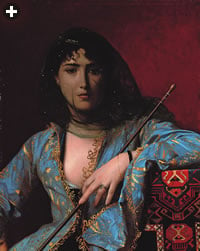 |
| SOTHEBY’S |
| “Femme Circassienne Voílée,” painted in 1876 by Jean-Léon Gérôme, sold in 2008 for more than two million pounds sterling. |
These shifts are part of a larger, gradual, mostly sympathetic reevaluation that has been taking place over the past few decades of much 19th-century Euro-pean art. For the Orientalists, the first signs of renewed appreciation came with the early oil boom of the 1970’s, when the Mathaf Gallery opened in London following the 1975 World of Islam Festival, marking the first specialist venue for the sale of Orientalism since the genre’s demise in the 1930’s. Mathaf was aimed particularly at the new market in the Middle East.
Since then, interest in Orientalist art has been led by the cognoscenti of the cultures depicted—mostly in the Arabian Peninsula, followed by North Africa. “The majority of my sales are still to Arab clients,” says Brian MacDermott, the gallery’s director. Controversy over the genre “has actually fueled a lot of interest,” he says—but not all controversy: “Naturally there’s a desire for accuracy relating to customs and traditions.” Even so, most of the paintings in an exhibition called “Enter the Harem” were bought by clients from the Arab world.
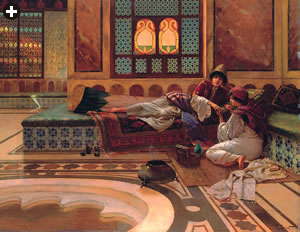 |
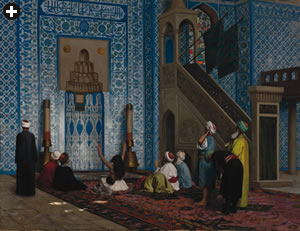 |
| TOP: CHRISTIE’S; Above: The Shafik Gabr Collection/Christie’s |
| Top: Renowned German Orientalist Rudolf Ernst exhibited his work regularly in Paris, including “The Manicure.” Like many Orientalist interiors, Ernst’s evoke both realistic domesticity and mild voyeurism. Above: Jean-Léon Gérôme has often been accused of voyeurism, too, which restricts the modern popularity of his work: “Rustem Pasha Mosque” is more accurate architecturally than in its casual depiction of Islam. |
And not long ago, that would have been surprising, because the harem was a defining motif of European Orientalism, and one of the most culturally sensitive at that. Though its basic meaning was “family quarters,” the word harem—derived from the Arabic word haram, meaning “forbidden”—was a kind of metaphorical screen onto which Euro-pean male artists imagined the lives of the women they could not see, and what they projected was at best inaccurate and kitsch and at worst lurid, voyeuristic and demeaning.
But men were not the only ones to paint “harem scenes.” Amid the most revealing and riveting of the paintings in the “Lure of the East” exhibition is “A Visit: Harem Interior, Constantinople,” 1860, by Henriette Browne, who was able to come and go in the women’s quarters. It depicts an austere, almost empty hall to which the visitors have even brought their own cushions, where a child clings uneasily to its mother. It is an ordinary moment amid polite but obviously tedious rituals and family matters.
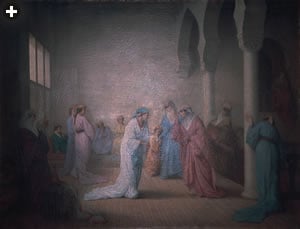 |
| TATE BRITAIN |
| “A Visit: Harem Interior, Constantinople,” by “Henriette Browne”—a pseudonym of Parisian artist Sophie Boutellier. |
Other Orientalist renderings of daily life in Arab lands tend to show two main settings: cities and deserts. The cities, however, are seemingly “medieval” or “timeless” vernacular scenes that exclude evidence of modernity. These include at times carefully observed traders and craftspeople (of pre-industrial pursuits), as well as the interiors and courtyards of homes, whose overwhelming detail and ornamental excess is rendered with meticulous draftsmanship. In these paintings, the brush lingered on tiles and textiles, carpets and architecture as the artist distilled a stereotypical, often languid atmosphere. But did those painters really paint—or even sketch—en plein air, right in the bazaars, with the flies and dust and hubbub? Some did, but others worked from photographs. Similarly, the interiors of most mosques—Orientalism’s second most popular motif—were off-limits at that time to non-Muslims, which raises more questions of accuracy in the minds of modern viewers and buyers.
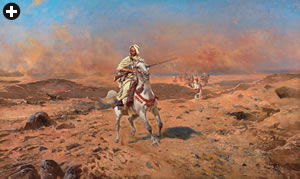 |
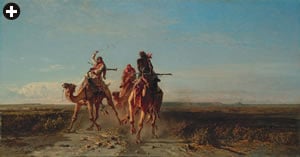 |
| Top:MATHAF GALLERY; Above:christie's |
| “The Road to Bizerte, Tunisia,” (1909), by Tadeusz Ajdukiewicz, top, and “The Camel Race” by Alberto Pasini, above, exemplify the Orientalist subgenre of desert landscapes, usually inhabited by Bedouin. |
The desert imagery draws on fascination with the traditional Bedouin ways in the Sahara and the Arabian desert. Here there are countless affectionate equestrian scenes of horsemen and cameleers watering their mounts, resting with them beneath oasis trees and even enjoying (almost certainly imaginary) dancing maidens. The Italian Orientalists, who depicted such scenes with charm and wit as studio painters, not travelers, even painted the women’s hairstyles and shoes with a noticeably fashionable Italian air! Many a hazy sunset landscape is depicted, and sometimes a legendary city like Petra appears on the skyline. Women are shown collecting water, trailing appealing children. In the “desert action” subgenre, Orientalists painted dramatic fantasias of men galloping on horse or camel across the sands, often to attack a trade caravan or raid a rival tribe’s camp.
Other types of more controversial subjects—such as slave markets and nudity—are being bypassed by today’s buyers. Christie’s Alexandra McMorrow comments tactfully that such subjects are “not seen by our clients as genuine.” Mathaf’s MacDermott says that such work would turn off his clients. As art and culture critic Rana Kabbani notes, “This is someone else’s story; someone else’s Orient.”
 |
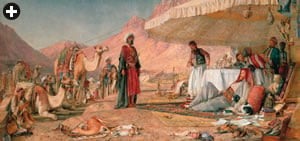 |
| Top:christie's; Above:TATE Britain |
| Top: Scenes such as “The Gate of the Great Umayyad Mosque,”(1890), by Gustav Bauernfeind are increasingly valuable as historical records. Above: “A Frank Encampment in the Desert of Mount Sinai,” was painted in 1856 by English painter John Frederick Lewis, who lived in Cairo from 1841 to 1850. |
 experience of being looked down on, being looked at from a position of greater power—which is often how these paintings appear to modern Arab buyers—is referred to in academia as “the gaze,” shorthand for the relationship between the painter and the subject of the painting. Analysis of the “gaze” has framed much of the scholarly discussion of Orientalism and has led to generalizations about western perceptions of the East during the 19th century. (Academics point out that there were no Middle Eastern artists painting scenes of western society.) Orientalism, says Kabbani, “has always rested on the peculiar premise that the West knows more about the Orient than the Orient knows about itself,” and thus the paintings embody a mixture of acquired knowledge and prejudice.
experience of being looked down on, being looked at from a position of greater power—which is often how these paintings appear to modern Arab buyers—is referred to in academia as “the gaze,” shorthand for the relationship between the painter and the subject of the painting. Analysis of the “gaze” has framed much of the scholarly discussion of Orientalism and has led to generalizations about western perceptions of the East during the 19th century. (Academics point out that there were no Middle Eastern artists painting scenes of western society.) Orientalism, says Kabbani, “has always rested on the peculiar premise that the West knows more about the Orient than the Orient knows about itself,” and thus the paintings embody a mixture of acquired knowledge and prejudice.
But this, too, may be changing. “I get bored with this ‘gaze’ business,” declares Raficq Abdulla. “You are different, so you will get looked at. But how you are perceived is vital.” If you are objectified, he continues, “it is indecent and demeaning, though most Orientalism is not so offensive.” Abdulla maintains that it is important for the Arab–Muslim world to transcend the notion that it is a victim of such western perceptions. He suggests that some commentators react negatively to Orientalism because they have been hurt by their colonial experience. “Palestine,” for example, he says, “remains a wound.”
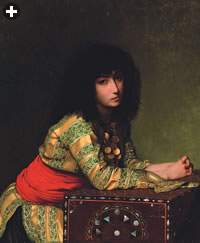 |
 |
| Top: The Shafik Gabr Collection/Christie’s; Above: Tate Britain |
| Top: “Jeune Fille Egyptienne,” by Jean-Léon Gérôme is regarded today as sensitive and individualized—much as the artist might have portrayed a European. Above left: As his 1866 “The Afterglow” shows, English Pre-Raphaelite William Holman Hunt was known for strong colors and symbolism. |
Most famously, the Palestinian–American intellectual Edward Said put a torch to debate over Orientalism in 1979 with the publication of his book Orientalism. In it he argued that the West’s imaginary artistic and literary notions of a static, passive and even morally degenerate East abetted Western colonialism, no matter how benign the apparent intentions of the paintings or the literature. He held that the “Grand Tour memorabilia” aspect of Orientalist painting was politically inexcusable, if not actively racist. Still today, no discussion of Orientalism is complete without consideration of Said’s critique.
“But if it’s cultural imperialism, why are the majority of buyers Middle Eastern?” retorts MacDermott, whose gallery had its own 2008 exhibition, “The British Orientalists: Eastern Views, Western Eyes.”
At Sotheby’s, Senior Vice President Ali Can Ertug responds by choosing his images carefully. “Certain images of Turkey honor me as a Turk. They are incredibly honoring of our heritage. They are historically important documentation for us because they are scenes we have not recorded, whereas in Europe that’s taken for granted. It’s lovely to have the earliest, sometimes the only, images of things that we have lost—like street-sellers, parts of Istanbul that have burned down, landscapes that have changed so radically, like panoramic views of the Bosporus. I find the Orientalists’ genuine interest flattering and valuable. I presume that people from Damascus and Cairo would be similarly honored.”
Like his colleagues, Ertug stresses historical accuracy in the Orientalist art market, which now affects price. For example, some Orientalists painted worshipers wearing shoes in mosques—something that is universally forbidden and that indicates the artist was painting from fantasy. “Those artists who are truthful get better prices at sales,” says Ertug.
The leading Orientalist artists who pass muster, says Christie’s McMorrow, include such well-known ones as Rudolf Ernst, Ludwig Deutsch, Alberto Pasini, John Frederick Lewis, Gustav Bauernfeind and portraits by Jean-Léon Gérôme—but not his large canvases, which, as Ertug points out, “eroticize the Middle East and can be erroneous, and are therefore questioned by Middle Eastern buyers.”
 with accuracy, ever-important matters of provenance—who has owned the painting previously, how was it obtained, how much has been paid for it—are now supplemented by a condition report—repairs to the canvas, relining and restoration—in determining the value of an Orientalist painting in today’s market. Interestingly, women have become very important buyers in their own right in the last decade. In much of the Middle East, women tend to be the leading decision-makers in matters relating to the home, and they have been instrumental in buying Orientalist art. “Oils for the majlis [the room where guests are received], something more decorative upstairs,” says Brian Mac-Dermott. He recently advised an audience of 50 women on collecting Orientalism at the Abu Dhabi Cultural Foundation, he says, and he lectures university and A-level students in Dubai, including sensible advice for these future collectors.
with accuracy, ever-important matters of provenance—who has owned the painting previously, how was it obtained, how much has been paid for it—are now supplemented by a condition report—repairs to the canvas, relining and restoration—in determining the value of an Orientalist painting in today’s market. Interestingly, women have become very important buyers in their own right in the last decade. In much of the Middle East, women tend to be the leading decision-makers in matters relating to the home, and they have been instrumental in buying Orientalist art. “Oils for the majlis [the room where guests are received], something more decorative upstairs,” says Brian Mac-Dermott. He recently advised an audience of 50 women on collecting Orientalism at the Abu Dhabi Cultural Foundation, he says, and he lectures university and A-level students in Dubai, including sensible advice for these future collectors.
 |
 |
| Christie's (2) |
| Top: “An Arab of the Desert of Sinai,” by John Frederick Lewis. Above: “The Jewellery Box,” by Rudolf Ernst. |
“I emphasize very much the dangers of forgeries. But what really encourages me is that most collectors, particularly in the Arab world, have bought for the right reason—because they like the painting, as opposed to viewing it as an investment. If it happens, as it has happened, that they’ve made a lot of money when they’ve sold it, they’re even more pleased. But very few of these paintings come back on the market. People who’ve bought them hold onto them.”
Another market shift is being driven by the burgeoning museum culture of the Gulf. Each of the Gulf countries has been gradually building national collections, and several of them contain important holdings of Orientalism, the only genre that depicts customs and traditions long forgotten or disappeared. One such new museum is the huge Sharjah Art Museum, hosting the last leg of “Lure of the East” tour. In Dubai, Sheikh Maktoum has set up his own museum, and the Qataris have also been collecting assiduously for their new museum. Ali Can Ertug
adds that Turkish museums have also been buying Orientalism extensively. Alexandra McMorrow comments that “cultural awareness now in the Middle East is feeding into the boom in museum investment.”
Often obscured by its own veils of stereotype and history, Orientalism remains a cultural legacy that inspired not only undisputed technical excellence but also complex understanding of the relationships among western and Arab worlds. For the largely Arab clientele who now find it so attractive, the visual poetry and unabashed nostalgia of Orientalist paintings are often pleasing respites in a rapidly changing world—much as their creators originally intended them to be.
 |
Writer, photographer and editor Juliet Highet is a specialist in Middle Eastern heritage and contemporary arts. Her book Frankincense: Oman’s Gift to the World was recently published by Prestel. A second book, Design Oman, is in preparation. She lives in Surrey. |